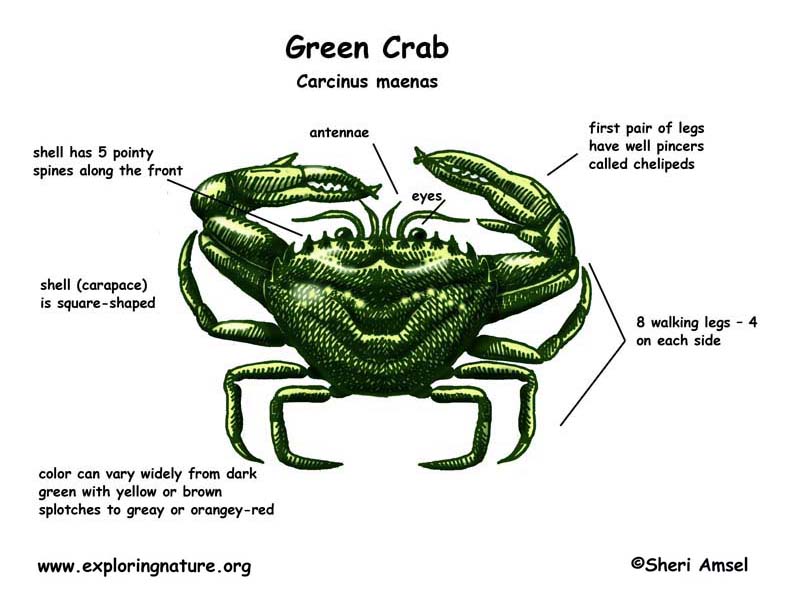

An invasive species that started in Europe, the green crab has spread to both coasts of North America, Iceland, Norway, Africa, Australia, and New Zealand. They are often the most common crab in their habitat. They have been an invasive species in North America for almost 200 years and are thought to have replaced other native crab species.
They live on rocky shorelines in tidal pools and in salt marshes and mud flats.
They are not large crabs, and usually are just 3" (8 cm) across. Their color can vary widely from dark green with yellow or brown splotches to orangey-red. Their shell (carapace), which is much more square-shaped than the blue crab, has 5 pointy spines along the front. They have 8 walking legs – 4 on each side and two larger claws. The first pair of legs have well-developed pincers called chelipeds. Males are larger.
They are active mainly at night (nocturnal). They are aggressive in their habitat and have out competed many native species.
They are omnivores eating plants and animals (clams, oysters, mussels and other small crabs). They both hunt (predators) and find dead animals to feed on (scavengers).
They are eaten by fish, sea birds, seals, otters and man.
Females lay up to 200,000 eggs. The hatching larvae float off into the ocean to develop offshore. They will grow and molt many times before developing into baby crabs. Like many small developing sea animals, young crabs will hide in kelp to grow and stay safe from predators.
Kingdom: Animalia
Phylum: Arthropoda
Subphylum: Crustacea
Class: Malacostraca
Order: Decapoda
Infraorder: Brachyura
Family: Portunidae
Genus: Carcinus
Species: C. maenas
When you research information you must cite the reference. Citing for websites is different from citing from books, magazines and periodicals. The style of citing shown here is from the MLA Style Citations (Modern Language Association).
When citing a WEBSITE the general format is as follows.
Author Last Name, First Name(s). "Title: Subtitle of Part of Web Page, if appropriate." Title: Subtitle: Section of Page if appropriate. Sponsoring/Publishing Agency, If Given. Additional significant descriptive information. Date of Electronic Publication or other Date, such as Last Updated. Day Month Year of access < URL >.
Amsel, Sheri. "Crab (Green)" Exploring Nature Educational Resource ©2005-2024. December 13, 2024
< http://www.exploringnature.org/db/view/547 >

